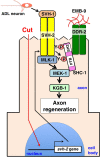The C. elegans Discoidin Domain Receptor DDR-2 Modulates the Met-like RTK-JNK Signaling Pathway in Axon Regeneration
- PMID: 27984580
- PMCID: PMC5161311
- DOI: 10.1371/journal.pgen.1006475
The C. elegans Discoidin Domain Receptor DDR-2 Modulates the Met-like RTK-JNK Signaling Pathway in Axon Regeneration
Abstract
The ability of specific neurons to regenerate their axons after injury is governed by cell-intrinsic regeneration pathways. However, the signaling pathways that orchestrate axon regeneration are not well understood. In Caenorhabditis elegans, initiation of axon regeneration is positively regulated by SVH-2 Met-like growth factor receptor tyrosine kinase (RTK) signaling through the JNK MAPK pathway. Here we show that SVH-4/DDR-2, an RTK containing a discoidin domain that is activated by collagen, and EMB-9 collagen type IV regulate the regeneration of neurons following axon injury. The scaffold protein SHC-1 interacts with both DDR-2 and SVH-2. Furthermore, we demonstrate that overexpression of svh-2 and shc-1 suppresses the delay in axon regeneration observed in ddr-2 mutants, suggesting that DDR-2 functions upstream of SVH-2 and SHC-1. These results suggest that DDR-2 modulates the SVH-2-JNK pathway via SHC-1. We thus identify two different RTK signaling networks that play coordinated roles in the regulation of axonal regeneration.
Conflict of interest statement
The authors have declared that no competing interests exist.
Figures






Similar articles
-
N-Glycosylation of the Discoidin Domain Receptor Is Required for Axon Regeneration in Caenorhabditis elegans.Genetics. 2019 Oct;213(2):491-500. doi: 10.1534/genetics.119.302492. Epub 2019 Aug 1. Genetics. 2019. PMID: 31371405 Free PMC article.
-
C. elegans Tensin Promotes Axon Regeneration by Linking the Met-like SVH-2 and Integrin Signaling Pathways.J Neurosci. 2019 Jul 17;39(29):5662-5672. doi: 10.1523/JNEUROSCI.2059-18.2019. Epub 2019 May 20. J Neurosci. 2019. PMID: 31109965 Free PMC article.
-
Caenorhabditis elegans F-Box Protein Promotes Axon Regeneration by Inducing Degradation of the Mad Transcription Factor.J Neurosci. 2021 Mar 17;41(11):2373-2381. doi: 10.1523/JNEUROSCI.1024-20.2021. Epub 2021 Jan 29. J Neurosci. 2021. PMID: 33514673 Free PMC article.
-
Factors regulating axon regeneration via JNK MAP kinase in Caenorhabditis elegans.J Biochem. 2020 May 1;167(5):433-439. doi: 10.1093/jb/mvaa020. J Biochem. 2020. PMID: 32091576 Review.
-
Signal transduction cascades in axon regeneration: insights from C. elegans.Curr Opin Genet Dev. 2017 Jun;44:54-60. doi: 10.1016/j.gde.2017.01.010. Epub 2017 Feb 16. Curr Opin Genet Dev. 2017. PMID: 28213159 Review.
Cited by
-
N-Glycosylation of the Discoidin Domain Receptor Is Required for Axon Regeneration in Caenorhabditis elegans.Genetics. 2019 Oct;213(2):491-500. doi: 10.1534/genetics.119.302492. Epub 2019 Aug 1. Genetics. 2019. PMID: 31371405 Free PMC article.
-
Reciprocal discoidin domain receptor signaling strengthens integrin adhesion to connect adjacent tissues.Elife. 2023 Jul 5;12:RP87037. doi: 10.7554/eLife.87037. Elife. 2023. PMID: 37405383 Free PMC article.
-
Transcriptomic analyses implicate neuronal plasticity and chloride homeostasis in ivermectin resistance and response to treatment in a parasitic nematode.PLoS Pathog. 2022 Jun 13;18(6):e1010545. doi: 10.1371/journal.ppat.1010545. eCollection 2022 Jun. PLoS Pathog. 2022. PMID: 35696434 Free PMC article.
-
An expanded GCaMP reporter toolkit for functional imaging in C. elegans.bioRxiv [Preprint]. 2023 Mar 8:2023.03.06.531342. doi: 10.1101/2023.03.06.531342. bioRxiv. 2023. Update in: G3 (Bethesda). 2023 Sep 30;13(10):jkad183. doi: 10.1093/g3journal/jkad183. PMID: 36945463 Free PMC article. Updated. Preprint.
-
[Research progress on intrinsic signaling pathways in axon regeneration].Zhejiang Da Xue Xue Bao Yi Xue Ban. 2020 May 25;49(1):82-89. doi: 10.3785/j.issn.1008-9292.2020.02.08. Zhejiang Da Xue Xue Bao Yi Xue Ban. 2020. PMID: 32621408 Free PMC article. Review. Chinese.
References
-
- O’Brien GS, Sagasti A (2009) Fragile axons forge the path to gene discovery: a MAP kinase pathway regulates axon regeneration. Sci Signal 2: e30. - PubMed
-
- Camps M, Nichols A, Arkinstall S (2000) Dual specificity phosphatases: a gene family for control of MAP kinase function. FASEB J 14: 6–16. - PubMed
MeSH terms
Substances
LinkOut - more resources
Full Text Sources
Other Literature Sources
Molecular Biology Databases
Research Materials
Miscellaneous

